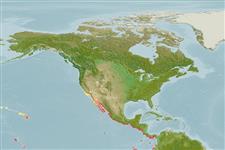Common names from other countries
Environment: milieu / climate zone / depth range / distribution range
Οικολογία
Θαλασσινό(ά); Γλυκού νερού; Υφάλμυρο βενθικό(ς); pH range: 7.5 - 9.5; αμφίδρομο (Ref. 51243); εύρος βάθους 1 - ? m. Subtropical; 25°C - 33°C (Ref. 36880); 41°N - 0°S
Eastern Pacific: Palos Verdes in southern California, USA to Peru.
Length at first maturity / Μέγεθος / Βάρος / Age
Maturity: Lm ?, range 17 - ? cm
Max length : 41.0 cm TL αρσενικό/απροσδιόριστο; (Ref. 5404); 39.0 cm TL (female); common length : 25.0 cm TL αρσενικό/απροσδιόριστο; (Ref. 55763); μεγ. δημοσιευμένο βάρος: 1.2 kg (Ref. 5404); μεγ. δημοσιευμένο βάρος: 1.2 kg
Short description
Κλείδες προσδιορισμού | Μορφολογία | Μορφομετρία
Body compressed; head flat; first dorsal fin with 7 spines, second with 1 spine and 8 to 9 rays; anal fin with 1 spine and 9 to 10 rays; lateral line with 30 to 34 scales; body depth contained about three times in standard length; body dark green to dark brown with numerous small pale spots (Ref. 55763).
Facultative air-breathing (Ref. 126274); Inhabit estuaries, stagnant ditches or creeks of low current velocity between the sea and an elevation of 30 m. Benthic and most abundant on sandy and muddy bottoms. Ingests much mud and detritus, although also filter plankton (Ref. 36880). Found in shallow inshore areas; typically in freshwater but moves freely into the sea.
Life cycle and mating behavior
Maturities | Αναπαραγωγή | Spawnings | Egg(s) | Fecundities | Προνύμφες
Eschmeyer, W.N., E.S. Herald and H. Hammann, 1983. A field guide to Pacific coast fishes of North America. Boston (MA, USA): Houghton Mifflin Company. xii+336 p. (Ref. 2850)
IUCN Red List Status (Ref. 130435)
CITES (Ref. 128078)
Not Evaluated
Threat to humans
Harmless
Human uses
αλιεία: Εμπορικό(ά); Υδατοκαλλιέργειες: Εμπορικό(ά)
Εργαλεία
Special reports
Download XML
Διαδικτυακές πηγές
Estimates based on models
Preferred temperature (Ref.
115969): 22.3 - 29.1, mean 26.8 (based on 208 cells).
Phylogenetic diversity index (Ref.
82804): PD
50 = 0.5312 [Uniqueness, from 0.5 = low to 2.0 = high].
Bayesian length-weight: a=0.01072 (0.00781 - 0.01470), b=3.11 (3.02 - 3.20), in cm Total Length, based on LWR estimates for this species (Ref.
93245).
Τροφικό Επίπεδο (Ref.
69278): 2.0 ±0.0 se; based on diet studies.
Ελαστικότητα (Ref.
120179): Υψηλό, ελάχιστος χρόνος για διπλασιασμό πληθυσμού < 15 μήνες (K=0.57).
Fishing Vulnerability (Ref.
59153): Low to moderate vulnerability (25 of 100).
